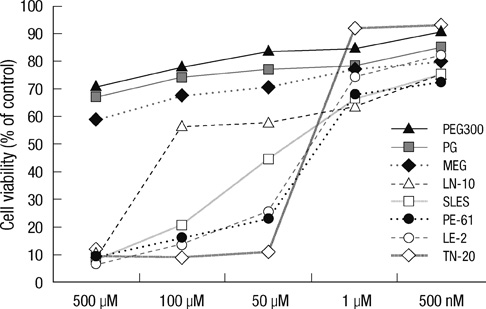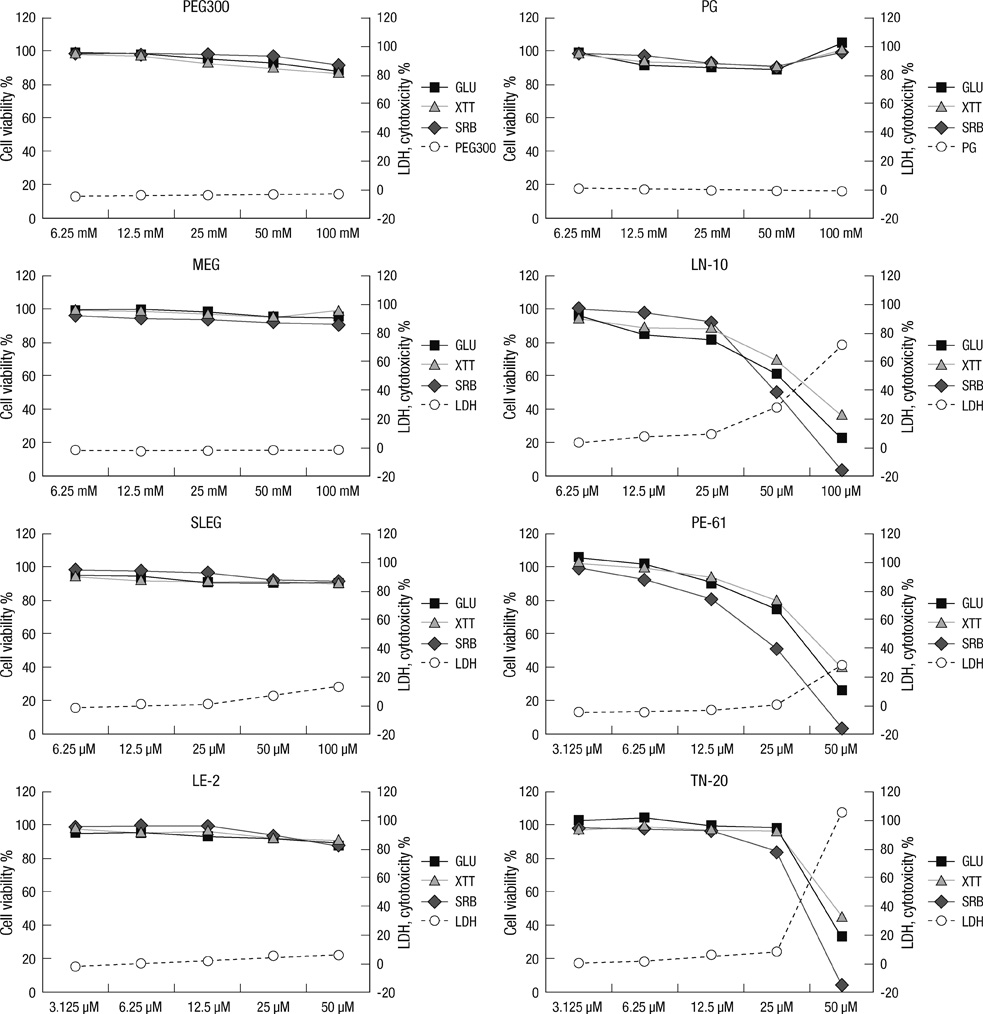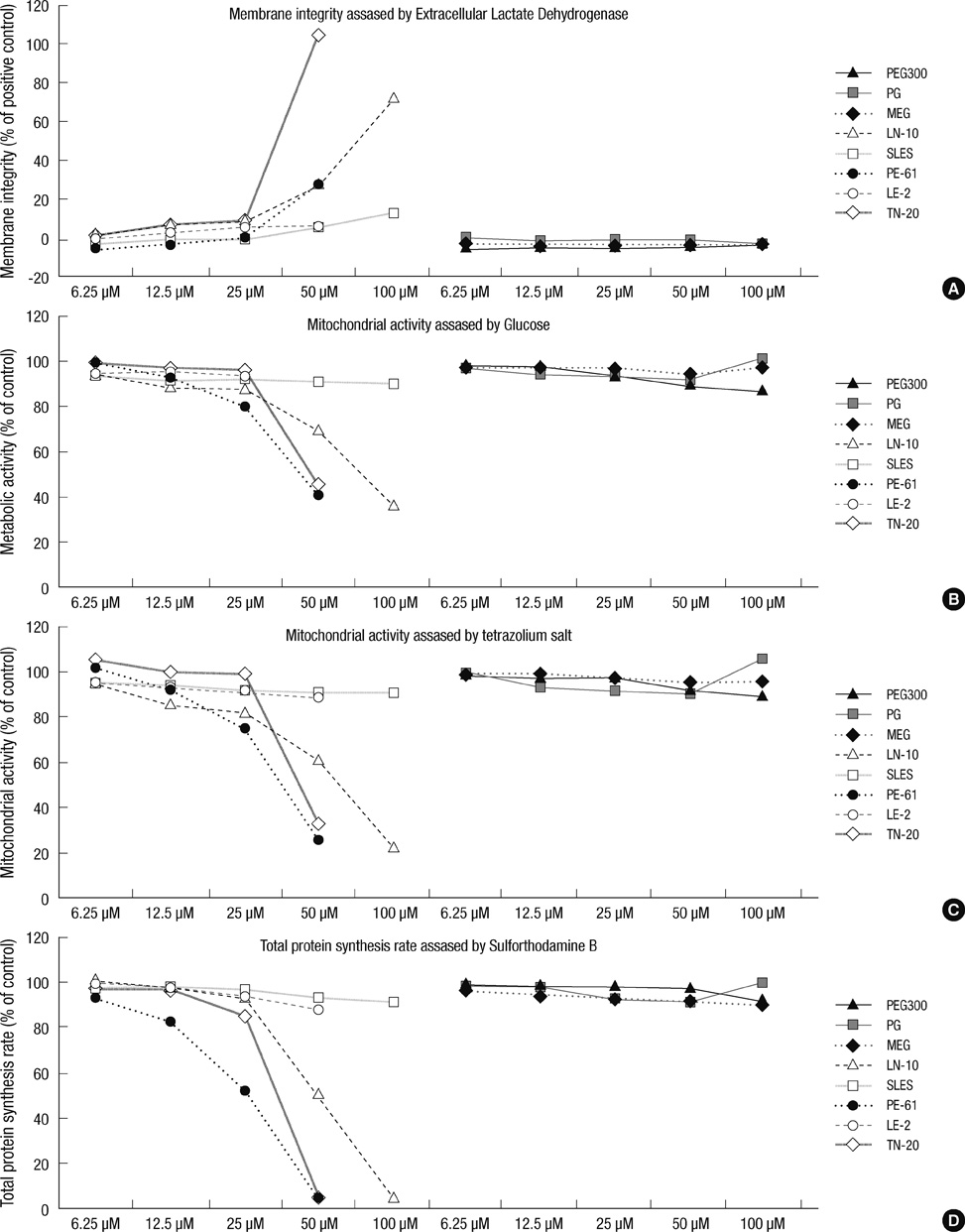J Korean Med Sci.
2012 Jan;27(1):3-9. 10.3346/jkms.2012.27.1.3.
Cellular Toxicity of Surfactants Used as Herbicide Additives
- Affiliations
-
- 1Department of Immunology, College of Medicine, Soonchunhyang University, Cheonan, Korea.
- 2Department of Internal Medicine, College of Medicine, Soonchunhyang University, Cheonan, Korea. syhong@sch.ac.kr
- KMID: 1792971
- DOI: http://doi.org/10.3346/jkms.2012.27.1.3
Abstract
- The cellular toxicities of surfactants, a solvent, and an antifreeze that are included in herbicide formulations were assessed by measuring their effects on membrane integrity, metabolic activity, mitochondrial activity, and total protein synthesis rate in a cell culture. Polyethylene glycol, propylene glycol, and monoethylene glycol exhibited no cellular toxicity even at a high concentration of 100 mM. Sodium lauryl ether sulfate and polyoxyethylene lauryl ether significantly damaged the membrane, disturbed cellular metabolic activity, and decreased mitochondrial activity and the protein synthesis rate; however, their toxicity was far below those of the severely toxic chemicals at comparable concentrations. The severely toxic category included polyoxypropylene glycol block copolymer, polyoxyethylene tallow amine, and polyoxyethylene lauryl amine ether. These surfactants were cytotoxic between 3.125 microM and 100 microM in a dose-dependent manner. However, the toxicity graph of concentration vs toxicity had a point of inflection at 25 microM. The slope of the toxicity graph was gentle when the concentration was below 25 microM and steep when the concentration was greater than 25 microM. In conclusion, our results suggest that the toxicity of surfactants be taken care of pertinent treatment of acute herbicide intoxication.
Keyword
MeSH Terms
Figure
Cited by 1 articles
-
Bilateral Basal Ganglia Lesion after Glufosinate Ammonium (BASTA®) Intoxication
Hak-Ju Oh, Hui-Chul Choi, Jong-Hee Shon, Min-Uk Jang, Chulho Kim
J Neurocrit Care. 2014;7(2):125-128. doi: 10.18700/jnc.2014.7.2.125.
Reference
-
1. Seok SJ, Gil HW, Jeong DS, Yang JO, Lee EY, Hong SY. Paraquat intoxication in subjects who attempt suicide: why they chose paraquat. Korean J Intern Med. 2009. 24:247–251.2. Nesime Y, Lokman B, Akif IM, Gurol C, Basar C, Mustafa K. Acute pesticide poisoning related deaths in Turkey. Vet Hum Toxicol. 2004. 46:342–344.3. Lee CH, Shih CP, Hsu KH, Hung DZ, Lin CC. The early prognostic factors of glyphosate-surfactant intoxication. Am J Emerg Med. 2008. 26:275–281.4. Gil HW, Seok SJ, Jeong DS, Yang JO, Lee EY, Hong SY. Plasma level of malondialdehyde in the cases of acute paraquat intoxication. Clin Toxicol (Phila). 2010. 48:149–152.5. Moon JM, Chun BJ. Predicting acute complicated glyphosate intoxication in the emergency department. Clin Toxicol (Phila). 2010. 48:718–724.6. Wu JY, Chang SS, Tseng CP, Deng JF, Lee CC. Parenteral glyphosate-surfactant herbicide intoxication. Am J Emerg Med. 2006. 24:504–506.7. Weng SF, Hung DZ, Hu SY, Tsan YT, Wang LM. Rhabdomyolysis from an intramuscular injection of glyphosate-surfactant herbicide. Clin Toxicol (Phila). 2008. 46:890–891.8. Temple WA, Smith NA. Glyphosate herbicide poisoning experience in New Zealand. N Z Med J. 1992. 105:173–174.9. Talbot AR, Shiaw MH, Huang JS, Yang SF, Goo TS, Wang SH, Chen CL, Sanford TR. Acute poisoning with a glyphosate-surfactant herbicide ('Roundup'): a review of 93 cases. Hum Exp Toxicol. 1991. 10:1–8.10. Palli E, Makris D, Diakaki C, Garoufalis G, Zakynthinos E. Rapture of the large intestine caused by severe oral glyphosate-surfactant intoxication. Am J Emerg Med. 2011. 29:459–460.11. Menkes DB, Temple WA, Edwards IR. Intentional self-poisoning with glyphosate-containing herbicides. Hum Exp Toxicol. 1991. 10:103–107.12. Lin CM, Lai CP, Fang TC, Lin CL. Cardiogenic shock in a patient with glyphosate-surfactant poisoning. J Formos Med Assoc. 1999. 98:698–700.13. Hung DZ, Deng JF, Wu TC. Laryngeal survey in glyphosate intoxication: a pathophysiological investigation. Hum Exp Toxicol. 1997. 16:596–599.14. Chang CY, Peng YC, Hung DZ, Hu WH, Yang DY, Lin TJ. Clinical impact of upper gastrointestinal tract injuries in glyphosate-surfactant oral intoxication. Hum Exp Toxicol. 1999. 18:475–478.15. Lee HL, Kan CD, Tsai CL, Liou MJ, Guo HR. Comparative effects of the formulation of glyphosate-surfactant herbicides on hemodynamics in swine. Clin Toxicol (Phila). 2009. 47:651–658.16. Baeurle SA, Kroener J. Modeling effective interactions of micellar aggregates of ionic surfactants with the Gauss-Core potential. J Math Chem. 2004. 36:409–421.17. Lee HL, Chen KW, Chi CH, Huang JJ, Tsai LM. Clinical presentations and prognostic factors of a glyphosate-surfactant herbicide intoxication: a review of 131 cases. Acad Emerg Med. 2000. 7:906–910.18. Bradberry SM, Proudfoot AT, Vale JA. Glyphosate poisoning. Toxicol Rev. 2004. 23:159–167.
- Full Text Links
- Actions
-
Cited
- CITED
-
- Close
- Share
- Similar articles
-
- In Vitro Cytotoxic Effect of Glyphosate Mixture Containing Surfactants
- Allergic Diseases in Childhood and Food Additives
- Severe chemical burns related to dermal exposure to herbicide containing glyphosate and glufosinate with surfactant in Korea
- Clinical Characteristics of Patients after Aryloxyphenoxy Propionate Herbicide Ingestion
- Surfactant preparations for preterm infants with respiratory distress syndrome: past, present, and future




